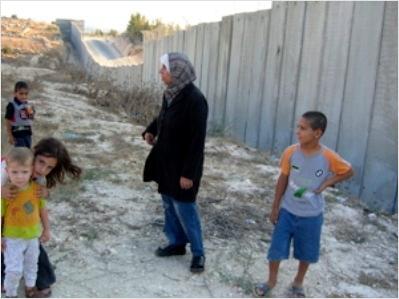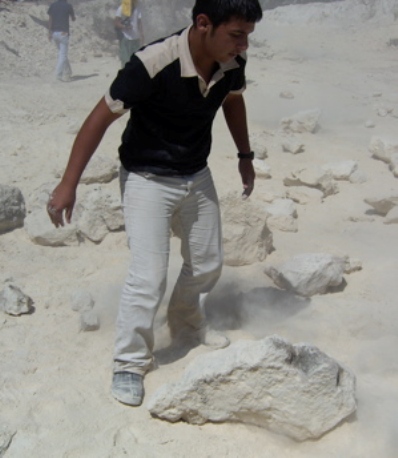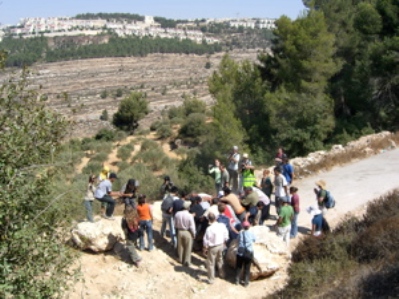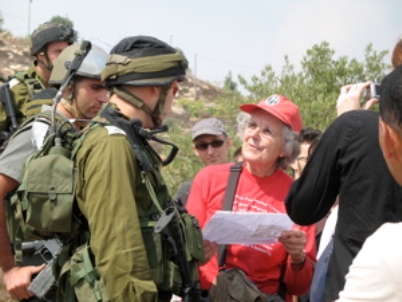Part II: Action against the Wall 5 October 2007 One of the strong impressions I get this year is that non-violent resistance to the Occupation has spread, and is strengthening and getting better organised. Palestinians have set up Popular Committees in many towns and villages specifically to plan non-violent action against the ever encroaching Wall and other threats of the Occupation.
The outstanding example has been the long campaign at the village of Bi'ilin, near the Green Line (the only internationally recognised boundary of between Israel and the Occupied Territories) west of Ramallah, north of Jerusalem. Every Friday for two and a half years the village planned and carried out a protest against the Wall, which cut them off from most of their land. Israeli peace activists and internationals joined them each week in the long series of creative and imaginative protests, frequently met with violent attacks by the Israeli security forces. In parallel with the protests, they engaged in an equally long drawn-out legal action in the Israeli Supreme Court. Their struggle was reported round the world, and culminated on 4 September in a victory in the Court, who ordered the IDF (Israeli Defence Forces) to dismantle a section of the Wall which they had already built, and move it 1.7 kilometres back towards the Green Line. This means that the nearby Israeli settlement of Matityahu is unable to expand eastwards onto Bi'ilin lands. There have been great celebrations of this victory - but the same Court decision allowed the existing settlement, which is also on Bi'ilin land, to remain. The overall message for Israeli settlers is to build fast and the Court will probably allow what is already built to stay, however illegal it is. But for now the partial success at Bi'ilin is inspiring actions every week in other Palestinian villages. On Friday, 21 September, Janet Benvie, recently arrived back on team from Scotland, and I went to Bethlehem to join the non violent protest in Walaja. This is a village between Bethlehem and the Green Line that will be completely surrounded by the Wall, on the present Israeli plan. It is in an area where an ancient forest on the hillside was a popular recreation area for Bethlehem families. We met up with a group from the Holy Land Trust, an ecumenical Palestinian and international Christian organisation opposed to the Occupation. They took us to Walaja in a minibus. I recognised some of the Israeli peace activists whom I had met in previous years. The Muslim villagers started with midday prayers, with a sermon, under the pine trees where they spread their prayer mats. Close by there was a large churned up bulldozed space reduced to nothing but sand and rocks. The language barrier meant that we did not immediately realise that this had been forest only a few weeks earlier.
2,300 trees are doomed to go in all. The Wall is set to run through there, very close to the village, leaving them no land. Its route takes no account of that, let alone of the environmental or recreational value of the forest. There tends to be quite a lot of waiting around on these occasions, before it becomes clear what we are doing. As it is Ramadan, the Moslem month of fasting from dawn to dusk each day, there was no eating or smoking or even having a drink of water. Eventually Shireen, a local leader of the protest, explained to us that we were going to unblock an access road. We headed down the steep hillside through the trees and scrub until we saw the road below us. A border police jeep was down there, but moved away and we did not see it or any soldiers for the rest of the time we were there. A Palestinian boy of 13 or 14 was very solicitous for me, showing me the best way down, and making sure I didn't slip - and inviting me to his home if I was in Walaja again. I stayed above the road to take photographs. It had been blocked by an Israeli bulldozer in the usual way, with giant rocks and rubble. The 50 or so activists set to work with their bare hands to clear a way through, rolling rocks to the edge of the road and tumbling them down among the olive trees below.
It looked as if the biggest boulders would never be moved this way, but then a small car drove up with some lengths of tough iron pipe to use as levers, and a hand grubber to help level the ground. A cheer went up as renewed efforts cleared a path for the car to get round the largest boulder, while the other big ones were successfully heaved off the road. Looking across the valley, the surrounding hills are completely covered by the Israeli settlements of Gilo and Har Gilo, which have grown very fast in the last ten years, and are part of the Gush Etzion Settlement bloc that has taken large tracts of Palestinian land. This bloc now surrounds Bethlehem on three sides and stretches to Jerusalem. It is one of the areas of which President Bush said in April 2004 to then Prime Minister Ariel Sharon, that of course Israeli centres of population inside the Green Line must remain part of Israel. The road the protestors cleared leads back to Bethlehem through the grounds of the Catholic Salesian monastery nearby, which makes the famous Cremisan wine. The Holy Land Trust minibus came to pick us up and drove us back that way, through the remaining part of the beautiful forest in the monastery grounds. The Catholic Church was given the choice by the Israelis of which side of the Wall they wanted the monastery to be - and they have chosen to be on the Israeli side severing their traditional links with Bethlehem. The villagers are angry and resentful that they have been abandoned by their neighbour, who will no longer be advocating on their behalf. The village of course had no choice, and is left scheduled to be cut off, with their only access through a tunnel. On the other side of Bethlehem, to the south-east, the large Israeli settlement of Efrat stretches along the hills almost to the village of Umm Salamouna. In May 2006, I took part in the first non-violent action ever by the villagers when they showed the media their maps and title to the land, confirmed by the Israeli Supreme Court 20 years before (see Planting virtual tomatoes, 4 May 2006). In December, back in New Zealand, I got word of the bulldozing of the land by the IDF. It was still a shock today, 5 October, to see the new road like a scar across the land, which marks the line where the Wall will be built, and the large extent of the land on the Efrat side which will be completely lost to the Palestinian farmers. To celebrate the International Day of Non Violence, 50 of us walked down from the village across the road and started up towards Efrat, where we could see a dozen soldiers waiting. Soon they were reinforced with a dozen more, who stood, fully armed of course, barring our path in stony silence, refusing to talk or to receive a message we had for them - a statement by Martin Luther King which we have as a poster in our apartment. The concrete Wall soon to go up there was matched by the wall of soldiers, and was in stark contrast to our message and banner, "We are sisters - we are brothers - Stand up for freedom". Our efforts seem puny, and hopelessly unequal in human terms, but not in terms of the human spirit.
Christina Gibb |



